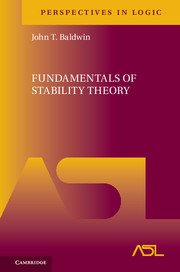Part D - The Number of Models
Published online by Cambridge University Press: 31 March 2017
Summary
In the remainder of this book, we calculate the possible spectra for two classes. If T is a countable superstable theory we will give the possible functions. If T is a countable ω-stable theory we will give the possible functions. A number of the theorems extend to more general classes of theories or to different classes of models. We have tried to build a framework which handles these more general cases. Thus, there are theorems and exercises referring to them. Some of the extensions we touch on are for any uncountable k, uncountable T, and small countable superstable T.
The calculation proceeds by first classifying the theories and then computing the spectra in each class. We begin with the fact, proved in Section IX.6, that if T is not superstable then. (We gave the proof only for regular k). Although we did not prove it here, it is shown in Chapter VII of [Shelah 1978], that I(k,S) = 2kThis justifies our assumption in the remainder of this book that T is superstable. Chapter XIV collects some of the main tools used in the computation. In Chapter XV we distinguish the bounded from the unbounded, or multidimensional, theories. We classify the spectra of bounded theories and compute a lower bound for the spectrum of an unbounded theory. Thereafter, we need only analyze unbounded theories. We also introduce in Chapter XV the notion of an eventually nonisolated type which is crucial for the study of countable models.
In Chapter XVI we introduce a major dividing line, the dimensional order property (DOP). We prove that if T has the dimensional order property then T has 2k S-models in every power We also find a flaw in our classification of the classes of models to study. That is, we will prove that a theory T has the DOP for all of the classes K introduced earlier or for none of them. But there is another variant, the ENI-DOP which must be investigated to deal with countable models.
- Type
- Chapter
- Information
- Fundamentals of Stability Theory , pp. 281 - 282Publisher: Cambridge University PressPrint publication year: 2017

